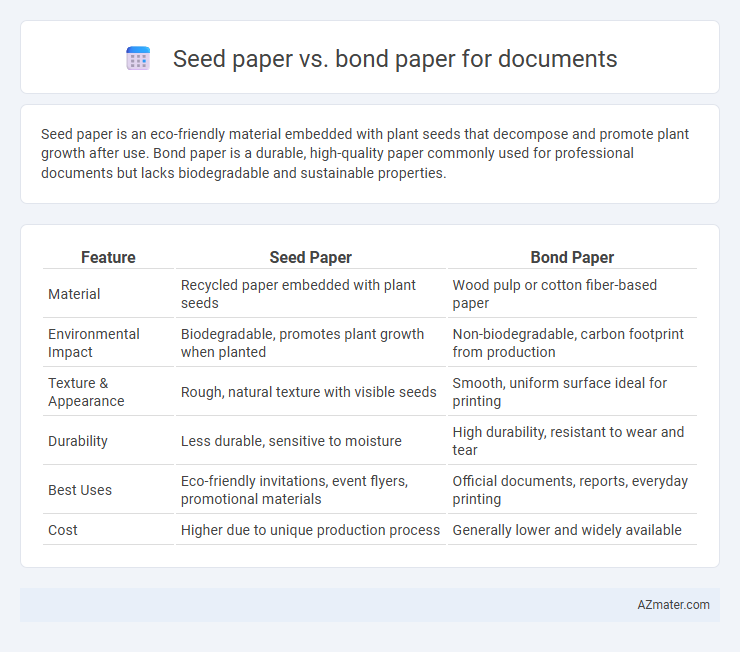Seed paper is an eco-friendly material embedded with plant seeds that decompose and promote plant growth after use. Bond paper is a durable, high-quality paper commonly used for professional documents but lacks biodegradable and sustainable properties.
Table of Comparison
| Feature | Seed Paper | Bond Paper |
|---|---|---|
| Material | Recycled paper embedded with plant seeds | Wood pulp or cotton fiber-based paper |
| Environmental Impact | Biodegradable, promotes plant growth when planted | Non-biodegradable, carbon footprint from production |
| Texture & Appearance | Rough, natural texture with visible seeds | Smooth, uniform surface ideal for printing |
| Durability | Less durable, sensitive to moisture | High durability, resistant to wear and tear |
| Best Uses | Eco-friendly invitations, event flyers, promotional materials | Official documents, reports, everyday printing |
| Cost | Higher due to unique production process | Generally lower and widely available |
Introduction to Seed Paper and Bond Paper
Seed paper is an eco-friendly paper embedded with seeds that can be planted after use, promoting sustainability and environmental awareness in document handling. Bond paper, known for its high durability and smooth finish, is widely used for official documents, letters, and printing due to its strength and professional appearance. Comparing seed paper and bond paper highlights the contrast between eco-conscious innovation and traditional, long-lasting paper options.
Defining Seed Paper: Features and Composition
Seed paper is an eco-friendly, biodegradable material embedded with natural seeds such as wildflowers, herbs, or vegetables, designed to be planted after use. Its composition includes recycled fibers combined with seed capsules that allow it to sprout when placed in soil and watered, promoting sustainability and reducing waste. Unlike traditional bond paper, seed paper serves a dual purpose of documentation and environmental contribution by enabling growth directly from the paper itself.
Understanding Bond Paper: Characteristics and Uses
Bond paper is a high-quality, durable type of paper commonly used for official documents, reports, and letterheads due to its strong fiber composition and smooth finish. Its weight often ranges from 16 to 24 pounds, providing a sturdy texture that enhances writing clarity and printing precision. Bond paper's versatility and professional appearance make it ideal for everyday office use and formal communications.
Environmental Impact: Seed Paper vs Bond Paper
Seed paper significantly reduces environmental impact by incorporating biodegradable materials embedded with seeds that promote plant growth after use, minimizing waste and supporting reforestation. Bond paper, typically made from virgin wood pulp, requires extensive water and energy consumption during production, contributing to deforestation and higher carbon emissions. Choosing seed paper for documents enhances sustainability efforts by promoting zero waste and encouraging natural regeneration compared to conventional bond paper.
Durability and Lifespan Comparison
Seed paper is biodegradable and designed to break down quickly, leading to a shorter lifespan compared to traditional bond paper. Bond paper is engineered for durability, resisting wear, tear, and environmental factors, making it ideal for long-term document storage. When prioritizing longevity and preservation, bond paper outperforms seed paper in durability and lifespan.
Print Quality and Aesthetic Differences
Seed paper offers a unique texture and natural fiber composition that enhances the tactile and visual appeal of printed documents, often resulting in a more organic, eco-friendly aesthetic. Bond paper provides a smoother surface with consistent weight and brightness, delivering sharper and more vibrant print quality suitable for professional and official documentation. The choice between seed paper and bond paper significantly affects the document's look and feel, with seed paper emphasizing sustainability and artistry, while bond paper prioritizes clarity and durability in printing.
Cost Analysis: Seed Paper vs Bond Paper
Seed paper, embedded with plant seeds, typically costs 20-30% more per sheet than conventional bond paper due to its eco-friendly materials and manufacturing process. While bond paper offers affordability with prices averaging $0.01 to $0.05 per sheet, seed paper ranges from $0.03 to $0.07 per sheet, impacting bulk order budgets significantly. The higher initial cost of seed paper is often offset by its sustainable appeal and marketing value, making it a strategic investment despite the price difference in document production.
Best Use Cases for Seed Paper
Seed paper is ideal for eco-friendly invitations, business cards, and promotional materials that emphasize sustainability by allowing recipients to plant the paper and grow flowers or herbs. It excels in marketing campaigns and event materials focused on environmental responsibility, offering a memorable, interactive experience. Unlike bond paper, which is suited for everyday printing and official documents, seed paper combines functionality with green innovation, making it best for unique, nature-inspired projects.
Ideal Applications for Bond Paper
Bond paper is ideal for official documents, legal papers, and professional reports due to its durability, smooth texture, and ability to hold ink well without bleeding. Its high-quality weight and opacity make it suitable for printing contracts, certificates, and business correspondence where readability and formality are crucial. Compared to seed paper, bond paper ensures long-lasting preservation and clean presentation in administrative and corporate environments.
Choosing the Right Paper for Your Documents
Seed paper offers an eco-friendly solution with embedded seeds that can grow into plants, making it ideal for promotional materials or invitations where sustainability is a priority. Bond paper, known for its durability and smooth finish, is preferred for official documents, letters, and everyday printing due to its professional appearance and reliable performance. Selecting the right paper depends on the document's purpose, desired environmental impact, and the impression you want to convey.

Infographic: Seed paper vs Bond paper for Document
 azmater.com
azmater.com